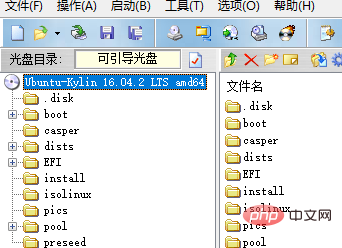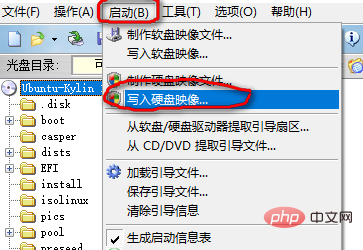Home >Operation and Maintenance >Linux Operation and Maintenance >How to boot linux from USB disk

Preparation work:
A 32G U disk (as the system disk), an 8G U disk (as the installation disk), an ubuntu ISO file, and An UltraISO software.
Method:
First download the ISO file of ubuntu
Then make the ubuntu installation disk, that is, install the Ubuntu startup disk
1. Open the UltraISO software (as an administrator), then select "File" -> "Open" and select the ubuntu ISO file you just downloaded

2. Select "Start" -> "Write Hard Disk Image", a dialog box will pop up

3. In the pop-up dialog In the box, a. "Hard drive": select the 8G USB flash drive. b. "Writing method": USB-HDD, c. Click Write to

Then install the Ubuntu system on the U disk
1) Plug two USB flash drives, 8G and 32G, into the computer and restart the computer. Enter the BIOS according to your computer brand. Some choose F2, F12, etc. differently.
2) Which "BOOT" option to choose. Change the first startup item to: the name of the 8G USB flash drive (select). My USB flash drive is from Kingston, so the first few words starting with "KING...".

3) Save and exit. Select the "SAVE" option. Below There is a "Save and Exit" and an "Exit without saving". Select "Save and Exit". It will automatically restart and enter the Ubuntu installation interface.

4 ), 4 options will appear, choose the second option, because the first option is for you to experience (starting with Try). The second one means installation immediately (starting with Install).

5) Then select the language:

#6) Set up wireless: used to install software, otherwise you have to install it yourself (also possible) . You can use your mobile phone to open a hotspot. Usually it is more than 100 M.

7) Select the first check box and install the corresponding software:

8) Click Continue, and a dialog box will appear. There may not be one, if so, select "Exit".

9) Select the "Custom Installation" option. If you select the first one, the startup items of the local computer will be modified. A USB disk must be inserted for each startup, and cannot be inserted into other computers for startup. Click Continue and you will enter the partition. Interface
10) Enter the size of the primary partition (don’t divide it all, divide it into 20G capacity, 20480M), select the primary partition, select the default EXT4 log file system when selecting options, and select the first "mount point" , that is, "/".
11) After selecting idle, click the number, select the logical partition, enter the capacity as 200M, select the default EXT4 log file system, and select /boot for the "mount point".
12) After selecting idle, click the number, select the logical partition, enter the capacity as 4096M, and select the swap space.
13) After selecting idle, click the number, select the logical partition, and enter The capacity is the remaining (no need to enter), select the default EXT4 log file system, and select /usr.
14) for the "mount point". An important point: select the "Device for installing the bootloader". For your U disk, just select /dev/sdc. The default is dev/sda. Do not select this, otherwise the data will be lost. Then click Install. A dialog box will pop up showing the contents of the format. See Check if there is your /dev/sda (it must not be there). Generally, the format /dev/sdc appears, which is of course. It should be the one you want to install on.
15) Select the time zone (usually SHANGHAI ).
16)Select the language.
17)Enter the login name and secret.
18)It is the installation. After the installation is complete, restart the machine.
19) After restarting, select which 32G U disk the startup item is. Or unplug the 8G USB flash drive.
Finish!
Recommended tutorial: linux tutorial
The above is the detailed content of How to boot linux from USB disk. For more information, please follow other related articles on the PHP Chinese website!